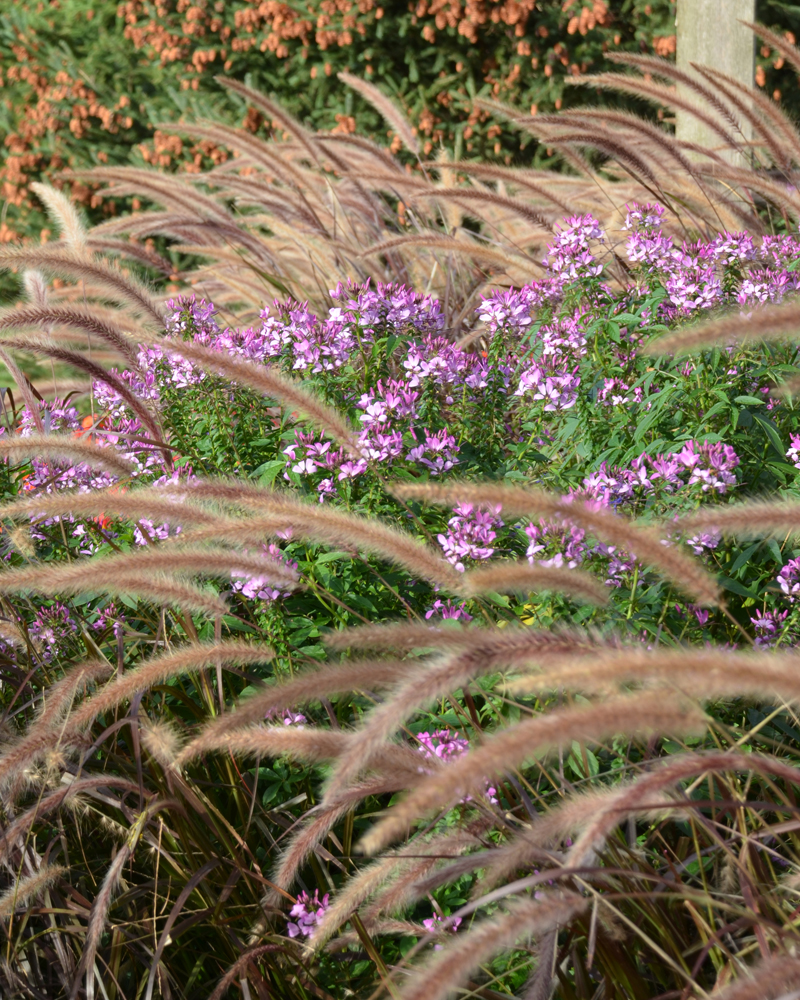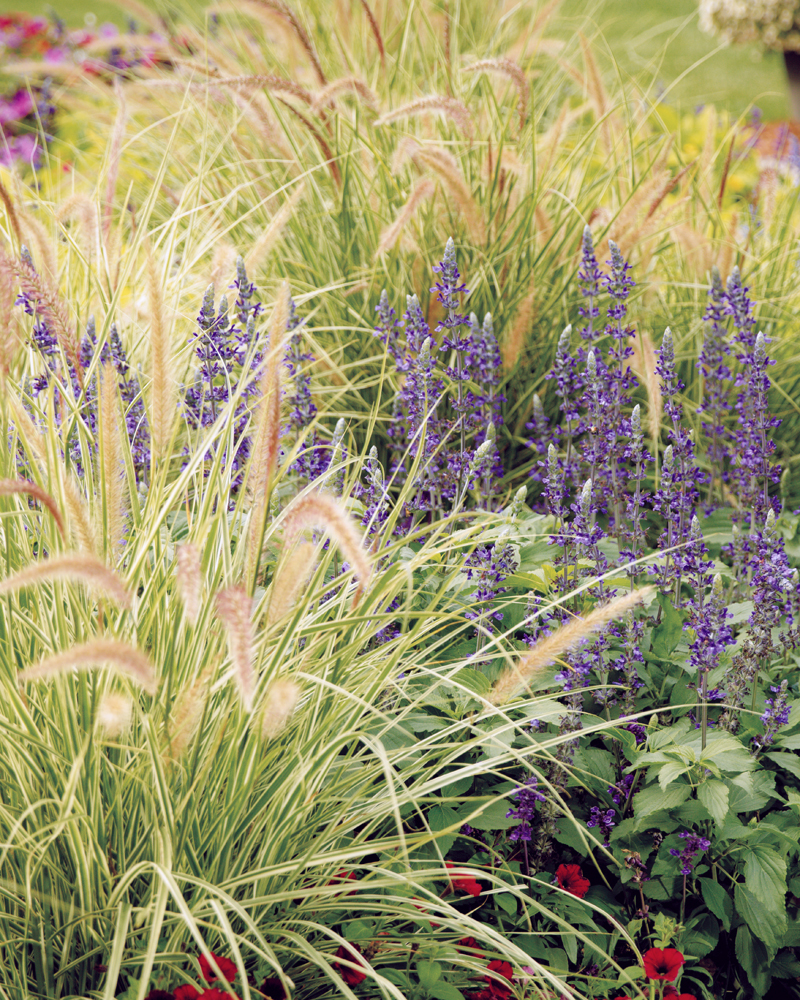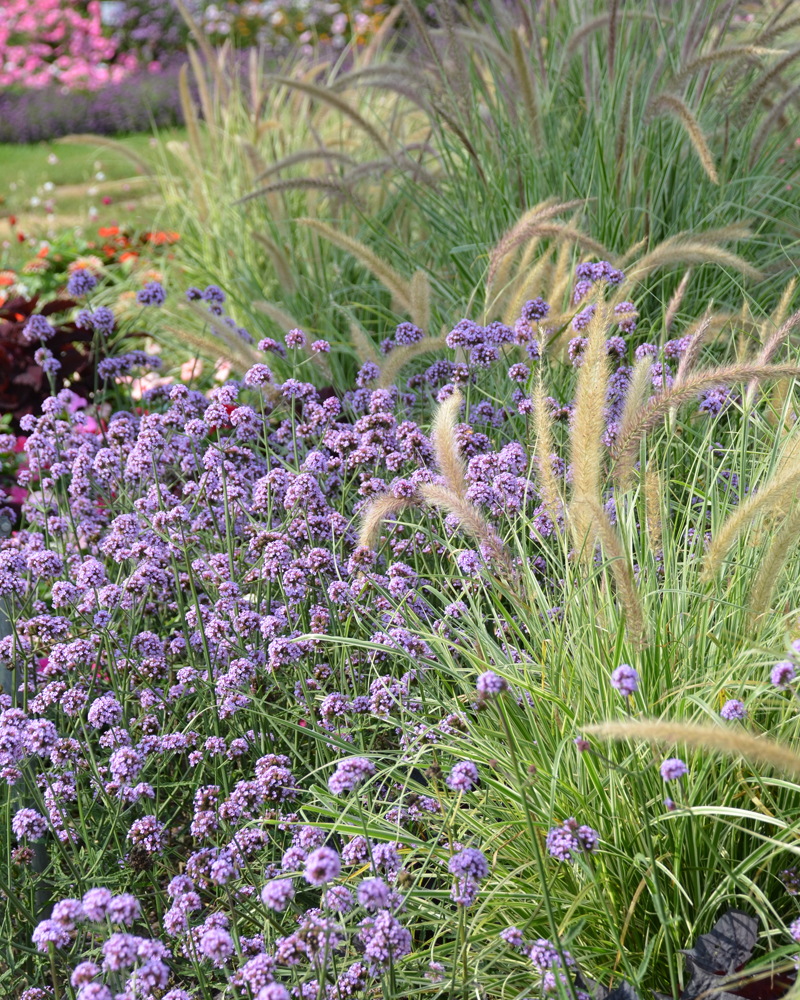10 Companions for Ornamental Grasses in the Landscape
You’ve selected a beautiful ornamental grass to add to your landscape. Now, what should you plant with it? Here are ten ideas for perfect pairings.

Think of any spot in your garden and there’s likely an ornamental grass to fit. This versatile group of plants suits all sorts of uses in landscapes, but it’s not always obvious what you should pair with them. A few details you’ll want to consider are the plants’ light and water needs, as well as their size. Perfect pairings include plants that enjoy the same growing conditions and are proportionate to one another.
Here are ten ornamental grass pairings you might consider for your own landscape.
Graceful Grasses® Vertigo® Pennisetum + Supertunia Vista® Petunias

Matching plants with similar vigor is the primary factor in this pairing. If you’re looking to fill a large space in a short amount of time, this is a beautiful and fairly inexpensive way to go.
Vertigo is an incredibly vigorous ornamental grass that can reach heights of 4-8’ with a similar girth in a single season. North of zone 8, it is grown as an annual and yes, it does get that big in one season! The photo you see here was taken near Detroit, Michigan, zone 5.
Supertunia Vista petunias are equally vigorous, with one plant growing 3-4’ across in a single season. They can easily compete with Vertigo for space in the landscape without getting swallowed up. Supertunia Vista® Bubblegum® is pictured here, and it also comes in four other colors that would pair beautifully with Vertigo.
Vertigo fountain grass and Supertunia Vista petunias enjoy full sun and average moisture conditions. They are both heat tolerant.
Graceful Grasses® Purple Fountain Grass + Señorita Rosalita® Cleome

Add a bright splash of purple that lasts through fall in your landscape by combining annual purple fountain grass with cleome. We chose varieties that grow to similar heights here and interplanted them to form a tapestry of fluffy foxtail plumes and rounded flower clusters. Senorita Rosalita cleome and purple fountain grass both typically max out around 3-4’ tall.
If you’d prefer a more layered look with the cleome planted in front and the grass behind it, choose Señorita Blanca® cleome which stays a little shorter at 18-36”.
Both of these plants will thrive in full sun with average water, and they are very heat tolerant. Since both are annuals, you’ll want to repeat this combination each year.
Graceful Grasses® ‘Sky Rocket’ Pennisetum + Rockin’® Playin’ the Blues® Salvia

Cool color palettes are a welcome sight, especially in warm climates. We love how this pairing gives us the fall feels without the use of the oranges and reds typical of the season. If you garden someplace where it is still tee shirt weather in October, this might be the perfect duo for you.
Fresh green and white striped ‘Sky Rocket’ annual fountain grass is paired with the cool blue spires of Rockin’ Playin’ the Blues salvia here. Blue, green and white is a classic color combination, and interplanting them helps the colors play off one another. You’ll have blue flowers from the time of planting, with fuzzy foxtail plumes joining the party from midsummer through fall.
Both of these plants prefer full sun to light shade, average moisture, and can reach heights of 3-4’. Yes, this is a very big salvia! And if you live in zones 7 or warmer, it should return for you each year.
Graceful Grasses® ‘Sky Rocket’ Pennisetum + Meteor Shower® Verbena

If blue and white is your color palette, then you’ll want to plant the Playin’ the Blues combination you saw above along with this one that features Meteor Shower verbena. Imagine both combinations running down your fence line or lining your driveway. A stunning view for such little effort!
Meteor Shower verbena is a plant that, once you grow it, you’ll want to have it in the garden every year. If you live in zone 7 or warmer, it will return on its own; elsewhere you’ll need to replant. There’s something magically magnetic about its flowers. Nearly every time you pass by, you’ll find bees or butterflies there feeding. There are plenty of blooms to go around, so be sure to pick a few for fresh bouquets.
This combination will thrive in full sun to light shade with average moisture. Both plants will reach heights of about 3’.
Prairie Winds® ‘Totem Pole’ Panicum + Lakota™ Fire Echinacea

With their native roots firmly planted in the prairies of eastern and middle America, you’ll find these two types of perennials are easily able to withstand full sun, heat, drought and less than ideal soils. Bees and butterflies are frequent visitors of coneflowers, while birds use the dried seed panicles of switch grass for nesting materials in spring.
We love how the hot red-orange to deep pink-red flowers of Lakota Fire contrast with the cool bluish foliage of ‘Totem Pole’ switch grass. Since its habit is very upright with a narrow footprint, this grass won’t overcrowd or shade out the coneflowers skirting its base. You could easily adapt this combination to work in a large or small space by adjusting the number of plants.
‘Totem Pole’ switch grass will return each year in zones 4-9 and grows 6’ tall by 2.5’ wide. Lakota Fire coneflowers are perennial in zones 4-8 and are a shorter selection, growing 12-16” tall and wide. They bloom from early summer into early fall.
Prairie Winds® ‘Cheyenne Sky’ Panicum + ‘Tuscan Sun’ Heliopsis

Like the ‘Totem Pole’ + Lakota Fire combination above, the two perennials you see here also share native roots from the Great Plains to the East Coast. They are easy to grow in full sun and average to somewhat dry soil. Bees and butterflies enjoy the daisylike blooms of ‘Tuscan Sun’, and birds enjoy the shelter ‘Cheyenne Sky’ provides in winter.
Since both of these perennials grow about 3’ tall, plant them side by side or near enough that the golden blossoms can play off of the dark red tones in the switch grass. Both will form a dense, non-spreading clump that you can’t see through, so take care not to plant something too short behind them that will get lost.
‘Cheyenne Sky’ switch grass is perennial in zones 4-9. ‘Tuscan Sun’ false sunflowers are a bit hardier, withstanding zones 3-9. Expect the reddish tones to start developing on this grass in early summer and the golden blooms to appear from midsummer through late summer.
Prairie Winds® ‘Apache Rose’ Panicum + Rock ‘N Grow® ‘Pride and Joy’ Sedum
In the perennial garden, autumn flowering sedums are as iconic as garden mums in fall. The start of their bloom means fall has officially arrived. The same could be said for switch grass; both come alive and show their true colors beginning in late summer and lasting well into fall.
We love how the airy panicles of ‘Apache Rose’ switch grass match the rosy pink tones of ‘Pride and Joy’ sedum. Since they bloom at the same time every year, you’ll get to enjoy this pairing for many years to come.
Grow these perennials in full sun and average to dry soils. ‘Apache Rose’ switch grass will grow 4’ tall, so you’ll want to plant the much shorter 10-12” tall ‘Pride and Joy’ sedum in front to bloom at its feet. This grass will return reliably in zones 4-9, while the sedum is a bit hardier in zones 3-9.
Prairie Winds® ‘Desert Plains’ Pennisetum + Low Scape Mound® Aronia

While many ornamental grasses can handle dry soils, fountain grass prefers consistent moisture. You’ll know it isn’t getting enough water if its leaf tips turn brown. Aronia also loves moist soils (though it can handle drier soils too). The perfect spot for this pairing would be an irrigated landscape border or slope in full sun.
We love the rich fall tones these two hardy plants offer; golds, oranges, reds and purples are quintessential fall colors. But there’s another advantage of pairing these two. Early in spring, when the grass is first starting to wake up from its winter nap, the Aronia will be showing off with loads of white flower clusters which attract pollinators. Deep purple-black fruit follows in summer.
‘Desert Plains’ fountain grass is perennial in zones 5-9 and grows 3-4’ tall. Plant it behind the shorter Low Scape Mound Aronia which grows 1-2’ tall in zones 3-9.
Graceful Grasses® ‘Fireworks’ Pennisetum + ‘Miss Violet’ Buddleia
Landscapes come alive when you add the element of movement. The fuzzy foxtail plumes of annual ‘Fireworks’ fountain grass sway in the slightest breeze while the fluttering of butterflies and pollinating bees brings movement to butterfly bush.
The rich jewel tones of variegated red fountain grass complement the purple plumes of ‘Miss Violet’ butterfly bush from midsummer into fall. We love how the arching shape of their flowers is echoed in one another. Since the butterfly bush grows a few feet taller than the grass, plant it behind or beside it. Then, skirt the grass with a white carpet of White Knight® sweet alyssum to get this look.
Grow this combination in full sun with average moisture and well-drained soil. ‘Miss Violet’ butterfly bush will return each year in zones 5-9 and grow 4-5’ tall. You’ll need to plant the 24-30” tall variegated red fountain grass and sweet alyssum annually.
Prairie Winds® ‘Cheyenne Sky’ Panicum + Winterberry Holly
Here’s a combination that goes the distance, delivering sumptuous red color from fall through winter in zones 4-9. ‘Cheyenne Sky’ switch grass colors up early and intensifies as the season progresses, reaching its peak when the winterberry holly turns red in fall. Though the grass will turn tan for winter, it continues to provide a beautiful backdrop for the bright red berries which persist through winter (or until the birds eat them!)
Another reason these plants make a great match is they both thrive in moist to wet soils. Switch grass is not fussy about soil; it can grow in almost any conditions as long as sunshine is plentiful. But winterberry holly does not like to dry out, so make sure to plant this duo where the hose or sprinklers reach.
Winterberry holly comes in different sizes, ranging from just a few feet to 8’ tall. ‘Cheyenne Sky’ switch grass stands three feet tall. If you’d like to plant a winterberry holly along the back of the border, choose a taller variety like Berry Heavy® or Berry Heavy® Gold. If you’d prefer to grow these two plants side by side, choose a shorter variety like Berry Poppins® or Little Goblin® Red. Remember, you’ll need to plant one compatible male holly for every five females to get the berries.
Want to learn more?




